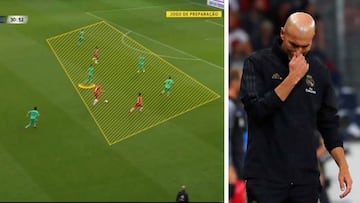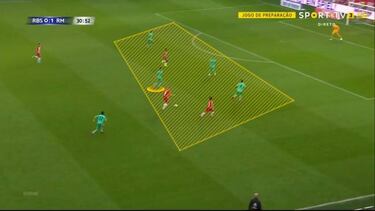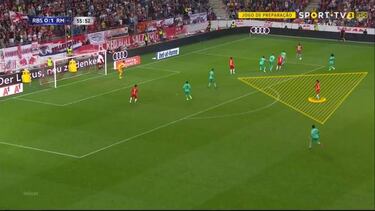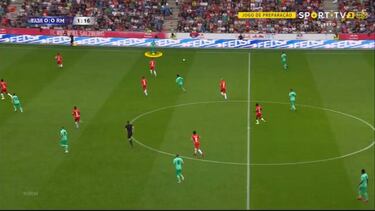Real Madrid: The verdict on Zidane's 3-5-2 at RB Salzburg
Zinedine Zidane opted for a change of system in Austria, in a bid to solve the issues Real Madrid have suffered during the pre-season period.

Having recorded just one win in five in an underwhelming pre-season period, Real Madrid boss Zinedine Zidane raised eyebrows on Wednesday by changing up his playing system for the friendly away to Red Bull Salzburg, setting his team up in a 3-5-2. It's a formation that Zidane had used just three times previously during his Madrid tenure - and not since 2017 - but, in view of the scant defensive solidity shown by Los Blancos so far this summer, he was at pains to find a way to shore up his side.
In the games they played before the trip to Austria, Madrid had been caught out time and again by their vulnerability in transition to defensive mode, with their attacking players less than assiduous about tracking back and their midfield dangerously porous. There was a distinct lack of balance and defensive order about the team, and Zidane sought to remedy that by fielding three centre-backs behind the protective shield of Casemiro in the holding role. Albeit it was against third-rate European opposition, it was a plan that initially had an impact. Half an hour or so into the match, however, the same old issues began to rear their head once more.
Ultimately, it was an experiment that dispelled few question marks.
Maintaining numerical superiority at the back
The decision to pick Raphael Varane, Sergio Ramos and Éder Militao together in defence was a reaction to Madrid's struggles in dealing with opposition counter-attacks. Against Bayern Munich, Arsenal, Atlético Madrid, Tottenham Hotspur and Fenerbahce, Madrid found themselves wide open both centrally and on the flanks, leaving the centre-backs badly outnumbered. Whenever the high press didn't work, defensive holes appeared left, right and centre. Against Salzburg, Madrid's off-the-ball pressing in the opposition half was again found wanting - they won the ball back just twice in attacking areas - but the inclusion of an extra defender brought a little more security to the backline and served to hide Dani Carvajal, Marcelo, Isco and Toni Kroos' shortcomings when it came to providing defensive balance.
Ramos and Varane contributed a total of 26 ball recoveries between them, but it was Casemiro's presence that proved key. With him in front of the defence, several threatening Salzburg forward forays were snuffed out. Of 15 attempted counter-attacks in the first half, indeed, the Austrians got a shot away just the once. Casemiro did not allow Salzburg's players to carry the ball into central areas, forcing them to shuttle it out to the flanks. Even if Madrid found themselves split in two as a team - a scenario that repeats itself game in, game out - they had the Brazilian and their three-man central defence to stop the hosts' attacking transitions (see image below). Although a cohesive defensive effort as a whole team was conspicuous by its absence, the use of the three defenders and a midfield stopper in Casemiro allowed Real Madrid to overcome the rest of the side's slackness in getting back.

Isco loses the ball, but Casemiro and Madrid's three centre-backs ensure the visitors maintain numerical superiority over Salzburg.
However, when Casemiro was taken off at half time, Madrid's lack of tactical discipline in midfield came to the fore. Federico Valverde remains a highly impulsive player, charging over-zealously after the man in possession and forgetting about his positional obligations. Although there can be no doubt the Uruguayan has plenty of margin for improvement in this area, he did not look comfortable in the 3-5-2, and the need for Isco and Kroos to work harder without the ball quickly became apparent.

With Nacho, Valverde and Ramos bunched too close together and Isco and Kroos failing to track back, Ashimeu is left in acres of space on the edge of the area.
Bringing the ball out from the back
The change of formation did not bring with it an improvement in the problems Madrid have endured when playing the ball out from the back. Tellingly, Los Blancos gave away possession as many as 27 times in their own half. To begin with, the visitors did look more comfortable on the ball as they initiated forward moves, but this, in truth, owed more to Salzburg's surprise at the new system than anything else. Varane and Militao opened out to the wings, Carvajal and Marcelo pushed up, and Isco and Kroos showed for the ball between wing-back and centre-half.
In the first half, Salzburg's 4-4-2 formation left their forwards outnumbered as they sought to press Madrid's back three, but head coach Jesse March's half-time switch to a 4-3-3, with the full-backs getting tight on Carvajal and Marcelo, solved that problem for the home side - and caused Madrid to struggle to build from deep once more. Unable to respond to Salzburg's tactical change, Madrid saw their play suffer, with Varane and Carvajal's struggles particularly evident (they lost possession 10 times in their own half). Having had over 60% possession in the first half hour, that percentage fell to 45 in the last 30 minutes of the encounter.
Attacking creativity
Real Madrid only looked happy going forward when they had the chance to break quickly, driving straight at the Red Bull Salzburg goal. The creativity of Eden Hazard and Karim Benzema brought about several attacking transitions that any defensive system would have found difficult to keep a lid on.
Related stories
Unpicking the Salzburg defence when it had time to get itself into position first was a different story, though: in 68 such attacks, Madrid created just one chance. At the end of the day, 3-5-2 tends to be a more reactive than proactive system, one that lends itself better to sides who like to counter at pace. Penetrating an already-set defence out wide can in particular be a problem: without the help of a winger ahead of him, Carvajal above all ran into difficulties. All too often he had to retrace his steps, and ended up making no fewer than 25 backwards passes.

Carvajal receives the ball out wide with no-one ahead of him.
